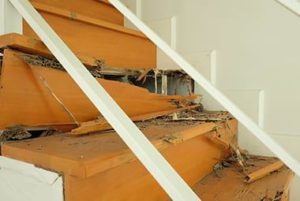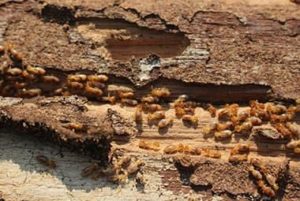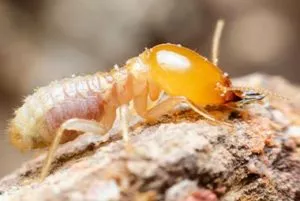Even though it’s only March, reports are already coming in: Termite swarms are occurring in East Tennessee. Swarm season started early this year because of the recent mild weather, so we decided to do a series of articles about termites so that residents in the area can be on their guard. Understanding termites is crucial for people living in the South where these little invaders do millions of dollars of damage a year. So, let’s take some time to study the enemy. In this post, we’ll discuss termite swarms and how they affect homeowners. Next time, we’ll cover practical ways to prevent and eliminate termites.
Normally, termites do not have wings (check out the photo from the pest experts at Univar). They are tiny, pail insects that almost look like grubs with legs. However, when the warm weather arrives, termites begin to focus on expanding their colony and growing their numbers. Colony members spend most of their lives underground (hence the name “subterranean termites”). But, when it’s time to expand, certain termites will develop wings. Termites with wings are capable of reproduction (which is usually left to queen). When the temperature and humidity are right, the winged termites will burst out of colony above ground. They are scattering themselves so that they can start new colonies with the original winged termite as the new queen. Since they are poor flyers, they leave the nest in a crowd so that even if predators take down many of the colony-builders, some are likely to survive.
Knowing about termite swarms is important for homeowners for a couple of reasons. The presence of the swarm indicates that new neighbors are trying to move in, and they’re going to need food fast. A swarm near a building indicates that the new colony will be foraging in that area. Many features of the home will be appealing for the buffet line, including support beams behind the walls, hardwood floors in the den, and cabinets in the kitchen. In addition, the presence of a swarm also indicates that a large, healthy colony is already nearby. Most of the members of an existing colony will not grow wings and scatter, which means that if you see hundreds or even thousands of swarming termites, there are many more underground throwing the goodbye party. A swarm near a building could indicate that termites are already feeding on the structure and causing damage.
A termite swarm will only last for a few minutes, which means you could easily miss the big event around your home. Be on the lookout for small groups of wings lying on your porch or around your foundation. The termites shed their wings after flying, and the lost wings are often a good indicator to homeowners that trouble is nearby. If you see a swarm, try to keep a couple of the dead bugs in a bag or jar for identification. We suggest that you call an exterminator immediately for a full inspection. Most companies, including Russell’s Pest Control, will inspect for free, allowing you to rely on an expert to identify whether your home is in danger. More information about termites can be found here, and you can call to request an appointment or just click here. If you want to see what a swarm looks like, check out this video on our Facebook page of some swarmers that we encountered last year.
Termite Swarms In Tennessee in Knoxville TN
Serving East Tennessee since 1971


